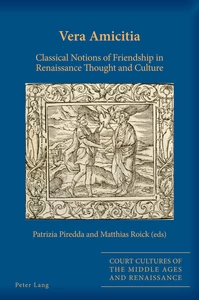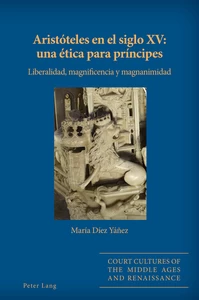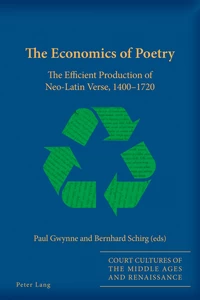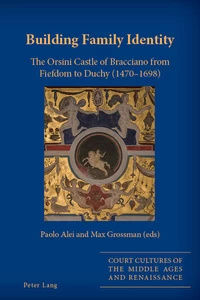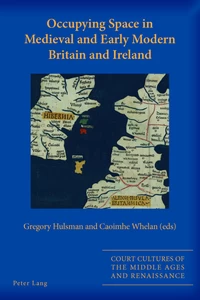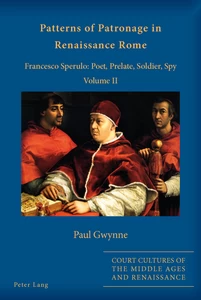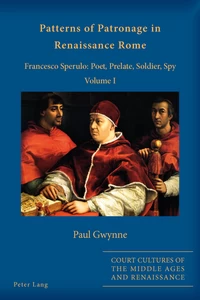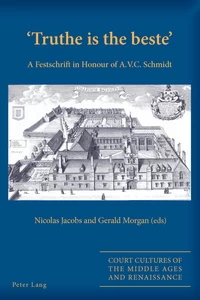Publications
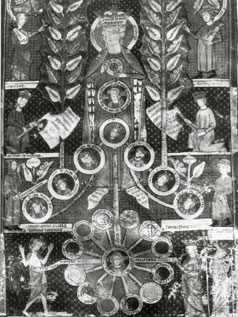
‘COURT CULTURES OF THE MIDDLE AGES AND RENAISSANCE’ (https://www.peterlang.com/series/6950)
is an inter- and multi-disciplinary book series established by the Centre for Medieval and Renaissance Studies and Peter Lang. It replaces our earlier series 'Medieval and Renaissance Court Cultures' published by Brepols (http://www.brepols.net/Pages/BrowseBySeries.aspx?viewClass=Print&TreeSeries=COURTS).
Books published in this refereed series will focus on the rich diversity of European and Renaissance court culture. They might, for example, look at the life and/or works of writers, artists, historiographers, soldiers, composers, diplomats and courtiers attached to the court in the East as well as the West. Another primary area could be that of courtlyritual (chivalric code, ceremonies, spectacle) and literary and artistic representations of the court. The role of the court in shaping national, religious and political identities might be explored as well as its function as an interface between different cultures. Editions of early works relating to the court will be a further feature of the series. The books published in the series may be both single-authored and multi-authored (including editions of articles on a common area). Editions will also be considered for publication in the series
This series aims to meet the needs of the scholarly and research community by publishing high quality research in the field (each proposal is closely vetted by the specialists on the Editorial Board and there is a comprehensive refereeing process); producing a series of works which highlight the centrality of the court to developments in Medieval and Renaissance culture on an international scale.
We would welcome proposals for books in this series. A 500-word abstract should be sent (or emailed) to:
Professor Sarah Alyn Stacey, FTCD,
Department of French/Centre for Medieval and Renaissance Studies
School of Languages, Literatures, and Cultures
Trinity College
Dublin 2
Ireland
Editorial Board:
- Sarah Alyn Stacey (Chief Editor)
- Bénédicte Boudou
- Brian Brewer
- Alan Fletcher
- John Law
- Rory McTurk
- Gerald Morgan
- David Scott-Macnab
Advisory Board:
Toby Osborne
Robert Knecht
Alcuin Blamires
Judith Bryce
Alan Deighton
Roger Stalley
William Marx
PUBLICATIONS TO DATE 2012-2022

Poets and Princes: The Panegyric Poetry of Johannes Michael Nagonius
by Paul Gwynne (Medieval and Renaissance Court Cultures', Brepols, 2012; http://www.brepols.net/Pages/BrowseBySeries.aspx?viewClass=Print&TreeSeries=COURTS).)
approx. X+436 p., 30 b/w ill. + 12 colour ill., 4 b/w line art, 156 x 234 mm
ISBN: 978-2-503-53160-1
Languages: English
Poets and Princes offers a richly textured interdisciplinary survey of late medieval and early Renaissance court cultures across Europe as they are reflected in the neo-Latin verse of the itinerant poet, Johannes Michael Nagonius.
Poets and Princes offers a richly textured interdisciplinary survey of late medieval and early Renaissance court cultures across Europe as they are reflected in the neo-Latin verse of the itinerant poet, Johannes Michael Nagonius. In 1496 the poet laureate Nagonius presented Henry VII with a manuscript of Latin panegyric poetry. This elaborate diplomatic gift from Pope Alexander VI solicited the King’s support against Charles VIII of France. The verse emphasized the mutual benefit of an alliance: if Henry supported him the Pope would acknowledge disputed Tudor claims to England’s throne. For Henry, the gift represented a literary and political coup. With all the rhetorical skill of a learned poet, Nagonius presented the King as a classical hero on an epic scale in the latest Italian style. The work thus acknowledged Henry’s international significance. Other recipients of Nagonius’s panegyric verse include Holy Roman Emperor Maximilian I, Vladislav II of Bohemia, Louis XII of France, Doge Leonardo Loredan, the condottieri Niccolò Orsini and Gian Giacomo Trivulzio, Giovanni Bentivoglio, lord of Bologna, and Duke Ercole d’Este of Ferrara. The presentation of a deluxe manuscript to Julius II, celebrating the pontiff ’s campaign in the Romagna, marked the climax of the poet’s career.
This analysis of the life and works of Nagonius thus provides a fascinating insight into the world of late medieval and early Renaissance court cultures. It contributes to the growing field of neo-Latin scholarship, examining the manuscripts and para-texts, studying the relationship between volume and dedicatee, placing these manuscripts within the wider literary and artistic cultures of the courts where they were presented, and investigating the role of neo-Latin verse within court cultures.
About the author:
Paul Gwynne received his Ph.D. in Combined Historical Studies from the Warburg Institute, University of London. His research interests include the reception of the Classical Tradition with particular emphasis on the development of Humanism in Renaissance Rome.
-
Vera Amicitia
Classical Notions of Friendship in Renaissance Thought and CultureVolume 10by Patrizia Piredda (Volume editor)Matthias Roick (Volume editor)2021Edited CollectionXVI, 288 Pages - This book investigates the meanings of the notion of friendship in the Renaissance from two perspectives, philological and philosophical, by observing how the notion was used in a broad spectrum of case studies of Renaissance culture. Each chapter highlights the ways in which authors of the sixteenth and seventeenth centuries (writers, philosophers, philologists, politicians, etc.) appropriated Greek and Latin paradigms of friendship, on the one hand, applying them to understand their own social and political context while, on the other hand, they created new paradigms of friendship in both the public and private spheres. Each chapter develops an argument on the notion of friendship starting from the investigation of a particular context and creating a network of connections between words related to friendship, such as speaking sincerely (parrhēsia), flattery, justice, love, pleasure, good, utility, virtue, good life, and truth, in both the private and public domains. The writers addressed in the various chapters are – with regard to the ancients – Plato, Aristotle, Epicurus, Plutarch, Cicero and Seneca and – among the moderns – Machiavelli, Montaigne, Thomas More, Erasmus, Juan de Mariana, Feliciano Silvestri, Johannes Caselius, the members of the Fruchtbringende Gesellschaft, and the authors of Renaissance emblem books.
-
Aristóteles en el siglo XV: una ética para príncipes
Liberalidad, magnificencia y magnanimidadVolume 7by María Díez Yáñez (Author)2020MonographsXVIII, 408 Pages - Los cambios geopolíticos que se producen a partir del siglo XV debilitan el equilibrio de poder en el que se encuentran las monarquías europeas.
Estas circunstancias obligan a apuntalar la supremacía política de los príncipes en todos los frentes, entre los que juegan un papel imprescindible la reafirmación de su poder en el plano moral y la consideración de las aspiraciones de la nobleza.
A lo largo del siglo XV tiene lugar en Europa, y particularmente en Castilla, dada su posición preeminente, un interesante juego de retroalimentación entre los discursos letrados, proclamas nobiliarias y manifestaciones culturales, en los que el recurso a la doctrina de Aristóteles gana peso progresivamente.
En estas páginas se ofrece un análisis filológico, moral y político de este esfuerzo intelectual por fundamentar, en el legado aristotélico, la superioridad moral del príncipe, poniendo el foco en el contexto político y cultural de determinados lectores, intérpretes y difusores del ideario del Filósofo.
Las formas medievales de la Ética y su diálogo con las del humanismo renacentista explican cómo el Filósofo se trasplanta en un terreno castellano, respondiendo a la demanda de unos intereses culturales e ideológicos de un reino que se embarca rumbo a la modernidad. -
The Economics of Poetry
The Efficient Production of Neo-Latin Verse, 1400–1720Volume 6by Paul Gwynne (Volume editor)Bernhard Schirg (Volume editor)2018Edited CollectionXVI, 462 Pages - The Economics of Poetry takes an innovative approach to the genre of Neo-Latin poetry, encompassing the entire process of poetic production, from composition and physical realization to the formal presentation to the honorand. This process was not predicated upon post-Romantic ideas of inspiration and originality, but rather upon the need to produce literary works in a timely fashion, often (though not exclusively) dependent upon the realities and exigencies of the contemporary political situation.
Applying this approach across more than three centuries of literary production, this volume analyses the techniques employed and developed by authors all around the world to reduce the effort of poetic composition, streamline its production and facilitate its presentation when time was a crucial factor in success. To reveal the efficient techniques which authors employed in order to meet their deadlines, each essay focuses on a variety of works by the same writer and examines the full context of their production. The re-use and recycling of previous texts and rhetorical templates – and even the re-dedication of previously presented manuscripts – emerges as a central and essential modus operandi in response to the strict dictates of fast production. -
Building Family Identity
The Orsini Castle of Bracciano from Fiefdom to Duchy (1470–1698)Volume 5by Paolo Alei (Volume editor)Max Grossman (Volume editor)2020Edited CollectionXXVI, 554 Pages - The Orsini of Bracciano were among the most powerful and influential signori di castelli of early modern Italy, controlling a vast domain that stretched from the Tyrrehenian Sea to the mountains of Abruzzo. This book explores the construction and decoration of their principal headquarters north of Rome between the fifteenth and seventeenth centuries as well as the careers and artistic patronage of its leaders, who included captains, condottieri, cardinals and urban aristocrats. The castle is one of the largest in Latium and was once a centre of courtly culture and diplomacy, hosting princes, kings and popes. Today it boasts many beautifully preserved artworks of the Renaissance era, including frescos by Antoniazzo Romano and the Zuccari brothers.
The contributors to this study investigate the castle as a visual expression of the family identity of its builders. They trace its evolution from the fortified capital of a large fiefdom at the dawn of the age of artillery to the palatial residence of a ducal dynasty in the aftermath of the Italian Wars. Richly illustrated with numerous historic and new photographs, this book analyses a fascinating and mostly neglected facet of early modern Italian culture: the artistic patronage of seigniorial clans. -
Occupying Space in Medieval and Early Modern Britain and Ireland
Volume 4by Gregory Hulsman (Volume editor)Caoimhe Whelan (Volume editor)2016Edited CollectionXVIII, 268 Pages - This collection offers a range of interdisciplinary viewpoints on the occupation of space and theories of place in Britain and Ireland throughout the medieval and early modern periods. It considers space in both its physical and abstract sense, exploring literature, history, art, manuscript studies, religion, geography and archaeology. The buildings and ruins still occupying our urban and rural spaces bridge the gap between the medieval and the modern; manuscripts and objects hold keys to unlocking the secrets of the past. Focusing on the varied uses of space enriches our understanding of the material culture of the medieval and early modern period. The essays collected here offer astute observations on this theme and generate new insights into areas such as social interaction, cultural memory, sacred space and ideas of time and community.
-
Patterns of Patronage in Renaissance Rome
Francesco Sperulo: Poet, Prelate, Soldier, Spy – Volume IIVolume 3by Paul Gwynne (Author)2015MonographsXXVI, 704 Pages - This book is also available as a set, together with Volume I.
Please visit www.peterlang.com/view/product/84550
Patterns of Patronage in Renaissance Rome is the first full-length study of the life and works of Francesco Sperulo of Camerino (1463–1531). In a remarkable career during which the poet progressed from serving as a soldier of fortune in the service of Cesare Borgia to an Italian bishopric, Sperulo produced a significant body of Latin poetry, here presented in a critical edition for the first time. An impressive array of contemporary figures including Leonardo da Vinci, Isabella d’Este, Raphael and Baldassare Castiglione appear in his verse. By placing his work within the larger historical, literary, political and social context, this study, published in two volumes, sheds light on the role played by neo-Latin poetry at the papal court and documents the impact of classical culture in Rome during the period usually referred to as «the High Renaissance».
Volume II presents a complete critical edition of all Sperulo’s surviving Latin works in poetry and prose, with translation and commentary. This remarkable œuvre documents Cesare Borgia’s conquest of Faenza, suggests to Raphael a programme for the fresco decoration of the Villa Madama, records conversations on love with Isabella d’Este, describes the newly-discovered antiquities and reports a sensational murder. Two orations, delivered on the eve of the Sack of Rome, celebrate a treaty between Spain and France and a Polish victory in the Crimean steppes. -
Patterns of Patronage in Renaissance Rome
Francesco Sperulo: Poet, Prelate, Soldier, Spy - Volume IVolume 2by Paul Gwynne (Author)2015MonographsXXVIII, 451 Pages - This book is also available as a set, together with Volume II.
Please visit www.peterlang.com/view/product/84550
Patterns of Patronage in Renaissance Rome is the first full-length study of the life and works of Francesco Sperulo of Camerino (1463–1531). In a remarkable career during which the poet progressed from serving as a soldier of fortune in the service of Cesare Borgia to an Italian bishopric, Sperulo produced a significant body of Latin poetry, here presented in a critical edition for the first time. An impressive array of contemporary figures including Leonardo da Vinci, Isabella d’Este, Raphael and Baldassare Castiglione appear in his verse. By placing his work within the larger historical, literary, political and social context, this study, published in two volumes, sheds light on the role played by neo-Latin poetry at the papal court and documents the impact of classical culture in Rome during the period usually referred to as «the High Renaissance».
Volume I reconstructs Sperulo’s life and circle of contacts by placing the poet’s works in chronological order and setting them within the political and social circumstances of their composition. Archival documents scattered across Italy, penitentiary records from the Vatican Archives and a voluminous correspondence with the Duke of Urbino and members of the Varano family of Camerino show that Sperulo was intimately involved in papal politics and intrigue; indeed, he was almost assassinated for his involvement. A selection of this correspondence is included here to supplement the poet’s biography. -
'Truthe is the beste'
A Festschrift in Honour of A.V.C. SchmidtVolume 1by Nicolas Jacobs (Volume editor)Gerald Morgan (Volume editor)2014Edited CollectionXXII, 217 Pages - The thirteen essays in this book, presented in honour of Dr A.V.C. (Carl) Schmidt, are designed to reflect the range of his interests. Dr Schmidt, who was a Fellow at Balliol College, Oxford from 1972 until his retirement in 2011, is best known for his comprehensive four-text edition of Piers Plowman, the fruit of a lifetime’s work on that text. He has also made a major contribution to the study of Chaucer and the medieval English contemplatives, and these authors also find a place in this collection. The essays presented here are intended to build upon the legacy of Carl Schmidt’s exemplary scholarship.
- Contributors include: Seamus Perry, J.A. Burrow, Mary Carruthers, Helen Cooper, Mary Clemente Davlin, P.J.C.Field, Alan Fletcher, Vincent Gillespie, Nicolas Jacobs, Rory McTurk, Gerald Morgan, Thorlac Turville-Petre
Editors: Nicolas Jacobs was, until his retirement, a Fellow of Jesus College, Oxford. His publications include (with A.V.C.Schmidt) Medieval English Romances, in the London Medieval and Renaissance Series (2 volumes, 1980), The Later Versions of 'Sir Degarre': A Study in Textual Degeneration (1995) and the edited volume Early Welsh Gnomic and Nature Poetry (2013).
Gerald Morgan, FTCD (1993), was, until his retirement, a Senior Lecturer in Trinity College Dublin where he taught from 1968. His publications include The Tragic Argument of 'Troilus and Criseyde (2 volumes, 2005), The Shaping of English Poetry (4 volumes to date, 2010, 2013, 2017) and the edited volume Chaucer in Context: A Golden Age of English Poetry (2012).
-
